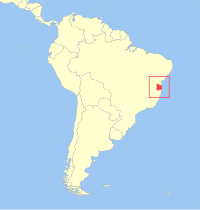Wied's marmoset
| Wied's marmoset | |
|---|---|
 |
|
| Wied's Marmoset at the Sugarloaf Mountain in Brazil. | |
| Scientific classification | |
| Kingdom: | Animalia |
| Phylum: | Chordata |
| Class: | Mammalia |
| Order: | Primates |
| Suborder: | Haplorrhini |
| Family: | Callitrichidae |
| Genus: | Callithrix |
| Species: | C. kuhlii |
| Binomial name | |
|
Callithrix kuhlii Coimbra-Filho, 1985 |
|
 |
|
| Distribution range | |
Wied's marmoset (Callithrix kuhlii), also known as Wied's black-tufted-ear marmoset, is a New World monkey that lives in tropical and subtropical forests of eastern Brazil. Unlike other marmosets, Wied's marmoset lives in groups consisting of 4 or 5 females and 2 or 3 males (plus children). They are matriarchal, and only the dominant female is allowed to mate. Like other marmosets, the offspring are always born in pairs.
This monkey supplements its diet of sap with fruit, nectar, flowers and seeds, as well as spiders and insects. Since these are harvested from the middle and lower part of the forest, Wied's marmoset often travels and forages in the company of the golden-headed lion tamarin, which forages in the canopy.
Wied's marmoset is eaten by birds of prey (the harpy eagle, the gray hawk, the roadside hawk and the white-tailed hawk), felines (the jaguar, jaguarundi and ocelot) and snakes.
Wied's marmoset is highly social, spending much of its time grooming. It has individually distinctive calls, and it communicates through gestures and olfactory markings as well.
The coloring of Wied's marmoset is mostly black, with white markings on cheeks and forehead. It has rings on its tail and black tufts of fur coming out of its ears.
Chimeric individuals carry two or more genetic cell lines in their bodies, each of which stems from a separate and genetically distinct zygote. This chimerism is the result of cell lines exchanged between siblings in utero. These two original zygotes were fertilized by two different sperm, which potentially came from more than one male. Therefore, chimeric individuals exhibit a phenotype that is the result of more than one genotype, and potentially more than one father.
...
Wikipedia

